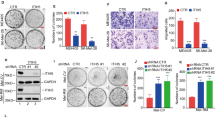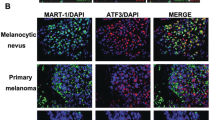Abstract
The Dickkopf (DKK) genes were originally identified as factors inducing head formation in Xenopus. The genes code for inhibitors that are involved in Wnt signaling. We speculate that loss of DKK expression plays a role in development or progression of malignant melanoma. Thus, we evaluated melanoma cell lines and tissue samples of malignant melanoma for loss of DKK, especially DKK-3 transcription. We found that DKK-1, -2 and -3 were downregulated or lost in all cell lines and in most of the tumor samples analysed. Reduced DKK-3 expression occurred as early as in primary tumors detected by both immunohistochemical and reverse transcription–polymerase chain reaction RT–PCR analysis. Functional assays with stable DKK-3 transfected cell lines revealed that DKK-3 expression increased cell-cell adhesion and decreased cell migration. Further, downregulation of fibronectin, snail-1 and re-expression of E-cadherin was found in the DKK-3 expressing cell clones supporting a role of DKK-3 in tumor progression. Our studies thus indicate that loss of DKK-3 expression may contribute to melanoma progression.
This is a preview of subscription content, access via your institution
Access options
Subscribe to this journal
Receive 50 print issues and online access
$259.00 per year
only $5.18 per issue
Buy this article
- Purchase on Springer Link
- Instant access to full article PDF
Prices may be subject to local taxes which are calculated during checkout







Similar content being viewed by others
References
Bachelder RE, Yoon SO, Franci C, de Herreros AG, Mercurio AM . (2005). J Cell Biol 168: 29–33.
Behrmann I, Wallner S, Komyod W, Heinrich PC, Schuierer M, Buettner R et al. (2003). Am J Pathol 163: 683–690.
Berking C, Takemoto R, Satyamoorthy K, Shirakawa T, Eskandarpour M, Hansson J et al. (2004). Cancer Res 64: 807–811.
Bittner M, Meltzer P, Chen Y, Jiang Y, Seftor E, Hendrix M et al. (2000). Nature 406: 536–540.
Bogenrieder T, Herlyn M . (2003). Oncogene 22: 6524–6536.
De Langhe SP, Sala FG, Del Moral PM, Fairbanks TJ, Yamada KM, Warburton D et al. (2005). Dev Biol 277: 316–331.
Gilles C, Polette M, Birembaut P, Brunner N, Thompson EW . (1997a). Clin Exp Metastasis 15: 519–526.
Gilles C, Polette M, Coraux C, Tournier JM, Meneguzzi G, Munaut C et al. (2001). J Cell Sci 114: 2967–2976.
Gilles C, Polette M, Mestdagt M, Nawrocki-Raby B, Ruggeri P, Birembaut P et al. (2003). Cancer Res 63: 2658–2664.
Gilles C, Polette M, Seiki M, Birembaut P, Thompson EW . (1997b). Lab Invest 76: 651–660.
Gonzalez-Sancho JM, Aguilera O, Garcia JM, Pendas-Franco N, Pena C, Cal S et al. (2005). Oncogene 24: 1098–1103.
Haass NK, Smalley KS, Herlyn M . (2004). J Mol Histol 35: 309–318.
Hsieh SY, Hsieh PS, Chiu CT, Chen WY . (2004). Oncogene 23: 9183–9189.
Hoang BH, Kubo T, Healey JH, Yang R, Nathan SS, Kolb EA et al. (2004). Cancer Res 64: 2734–2739.
Jacob K, Wach F, Holzapfel U, Hein R, Lengyel E, Buettner R et al. (1998). Melanoma Res 8: 211–219.
Kobayashi K, Ouchida M, Tsuji T, Hanafusa H, Miyazaki M, Namba M et al. (2002). Gene 282: 151–158.
Krupnik VE, Sharp JD, Jiang C, Robison K, Chickering TW, Amaravadi L et al. (1999). Gene 238: 301–313.
Laux H, Tomer R, Mader MT, Smida J, Budczies J, Kappler R et al. (2004). Lab Invest 84: 1372–1386.
Lee AY, He B, You L, Xu Z, Mazieres J, Reguart N et al. (2004). Biochem Biophys Res Commun 323: 1246–1250.
Li G, Fukunaga M, Herlyn M . (2004). Exp Cell Res 297: 142–151.
Monaghan AP, Kioschis P, Wu W, Zuniga A, Bock D, Poustka A et al. (1999). Mech Dev 87: 45–56.
Pham K, Milovanovic T, Barr RJ, Truong T, Holcombe RF . (2003). Mol Pathol 56: 280–285.
Pla P, Moore R, Morali OG, Grille S, Martinozzi S, Delmas V et al. (2001). J Cell Physiol 189: 121–132.
Poser I, Dominguez D, de Herreros AG, Varnai A, Buettner R, Bosserhoff AK . (2001). J Biol Chem 276: 24661–24666.
Roman-Gomez J, Jimenez-Velasco A, Agirre X, Castillejo JA, Navarro G, Barrios M et al. (2004). Br J Cancer 91: 707–713.
Tester AM, Ruangpanit N, Anderson RL, Thompson EW . (2000). Clin Exp Metastasis 18: 553–560.
Tsuji T, Miyazaki M, Sakaguchi M, Inoue Y, Namba M . (2000). Biochem Biophys Res Commun 268: 20–24.
Weeraratna AT, Jiang Y, Hostetter G, Rosenblatt K, Duray P, Bittner M et al. (2002). Cancer Cell 1: 279–288.
Yamaguchi Y, Itami S, Watabe H, Yasumoto K, Abdel-Malek ZA, Kubo T et al. (2004). J Cell Biol 165: 275–285.
Yook JI, Li XY, Ota I, Fearon ER, Weiss SJ . (2005). J Biol Chem 280: 11740–11748.
Ziegler-Heitbrock HW, Munker R, Johnson J, Petersmann I, Schmoeckel C, Riethmuller G . (1985). Cancer Res 45: 1344–1350.
Acknowledgements
We are indebted to Dr J Johnson (University of Munich, Germany) for providing melanoma cell lines and to Susanne Wallner for excellent technical assistance. This work was supported in part by grants from the DFG and the Deutsche Krebshilfe to AB
Author information
Authors and Affiliations
Corresponding author
Rights and permissions
About this article
Cite this article
Kuphal, S., Lodermeyer, S., Bataille, F. et al. Expression of Dickkopf genes is strongly reduced in malignant melanoma. Oncogene 25, 5027–5036 (2006). https://doi.org/10.1038/sj.onc.1209508
Received:
Revised:
Accepted:
Published:
Issue Date:
DOI: https://doi.org/10.1038/sj.onc.1209508
Keywords
This article is cited by
-
Vemurafenib and trametinib reduce expression of CTGF and IL-8 in V600EBRAF melanoma cells
Laboratory Investigation (2017)
-
Human Cancer Cells Signal Their Competitive Fitness Through MYC Activity
Scientific Reports (2017)
-
Genetic variations of DICKKOPF family genes might not be associated with gastric cancer susceptibility
BMC Gastroenterology (2016)
-
The induction of antigen-specific CTL by in situ Ad-REIC gene therapy
Gene Therapy (2016)
-
Serum level of DKK-1 and its prognostic potential in non–small cell lung cancer
Diagnostic Pathology (2014)



